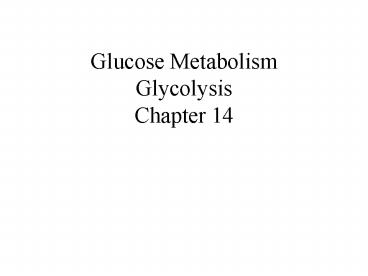Glucose Metabolism Glycolysis Chapter 14 - PowerPoint PPT Presentation
1 / 26
Title:
Glucose Metabolism Glycolysis Chapter 14
Description:
Keep track of CO2 released. ATP formed. High energy ... Activating. energy- requiring. Glucose. 2ATP. Fructose-1,6-bisphosphate. 2ADP 2P. 4ADP 4P ... – PowerPoint PPT presentation
Number of Views:86
Avg rating:3.0/5.0
Title: Glucose Metabolism Glycolysis Chapter 14
1
Glucose MetabolismGlycolysisChapter 14
2
Glucose (6C)
Glycolysis
2 pyruvate (3C)
Ethanol fermentation
Lactic acid fermentation
Respiration
Anaerobic
3
Keep track of CO2 released ATP formed High energy
electrons stored
4
Glucose Metabolism
Glucose (6C) 2 Pyruvate (3C)
2ATP
2NADH
Glycolysis
4ATP
2ATP
2 ATP
6CO2
8NADH 2FADH2
Ethanol CO2
Lactate (3C)
Anaerobic glycolysis
2ATP
Anaerobic alcohol Fermentation
Aerobic Respiration
5
Glycolysis
Energy yield 2 ATP 2 NADH
6
Glucose
Phase 1 Energy Requiring
Uses 2 ATP
Phase 2 Energy yielding
Yields 4 ATP
Pyruvate
Net 2 ATP
7
Glucose
Glycolysis
Activating energy- requiring
2ADP 2P
2ATP
Fructose-1,6-bisphosphate
4ATP
4ADP 4P
2NADH
2 pyruvate
8
1
Hexokinase
H
HO
Glucose-6-P
Glucose
9
Types of Enzymatic Reactions
- Kinase Transfers a phosphate from
- ATP to a substrate.
10
Reaction 1
Conversion of glucose to glucose-6-P
Glucose Pi ? Glucose-6-phosphate H2O
DGo 3.3 kcal/mole
ATP H2O ? ADP Pi
DGo -7.3 kcal/mole
Glucose ATP ? glucose-6-P ADP
DGo -4.0 kcal/mole
11
Glucosephosphate isomerase
2
Glucose 6-P
Fructose 6-P
Aldose
Ketose
12
Types of Enzymatic Reactions
- Kinase Transfers a phosphate from
- ATP to a substrate.
- Isomerase Transforms an aldehyde to
- a ketone vice-versa.
13
3
Phosphofructokinase
ADP
Fructose 6-P
Fructose-1,6-bis-P
2 molecules of ATP used thus far.
14
Glucose
Glycolysis
Activating energy- requiring
2ADP 2P
2ATP
Fructose-1,6-bisphosphate
4ATP
4ADP 4P
2NADH
2 pyruvate
15
Energy-yielding
4
Aldolase
16
Types of Enzymatic Reactions
- Kinase Transfers a phosphate from
- ATP to a substrate.
- Isomerase Transforms an aldehyde to
- a ketone vice-versa.
- 3. Aldol condensation Condensation of an
- aldehyde and a ketone.
17
5
Triosephosphate isomerase
Dihydroxyacetone phosphate
D-glyceraldehyde 3-phosphate
Net 2 molecules of D-glycerladehy-3P for each
glucose you start with.
18
Types of Enzymatic Reactions contd.
- Dehydrogenase Removes two elections
- and 2 H ions from a substrate and transfers
- them to NAD or FAD.
19
Dehydrogenases
- the -CHO group is oxidized to a carboxyl group
- the oxidizing agent, NAD, is reduced to NADH
NADH
20
6
Glyceraldehyde 3-phosphate dehydrogenase
H
High energy bond
Glyceradehyde 3-P
Aldehyde
Reduction
1,3-bisphosphoglycerate
Oxidation
Acid
21
Energetics
DG ooverall DG ooxidation DG
ophosphorylation
-43.1 kJ/mol
49.3 kJ/mole
Net 6kJ/mole 1.5 kcal/mole
22
Phosphoglycerate kinase
7
ATP is formed by substrate phosphorylation
Directly by an enzymatic reaction
23
What is the DGo ?
1,3-bisphosphoglycerate?3-phosphoglycerate Pi
DGo -11.8 kcal/mol
ADP Pi ? ATP
DGo 7.3 kcal/mole
1,3-bisphosphoglycerate ADP ?
3-phosphoglycerate ATP
DGo -4.5 kcal/mol
24
- Important points
- Glycolysis is a very important
- pathway in the metabolism of glucose.
- In glycolysis, 1 molecule of glucose is
- converted into 2 molecules of pyruvate
- with the net formation of 2 molecules
- of NADH and 2 molecules of ATP
25
3. Glycolysis can be divided into two phases
(1) energy-requiring and (2) energy-releasing.
4. In the energy-requiring steps, 2 ATP
are used and 1 fructose-1,6-bisphosphate is
formed.
26
- In the energy-yielding steps,
- 2 molecules of pyruvate,
- 4 molecules of ATP
- and 2 NADH molecules are produced.
6. Glycolysis yields only 2 ATP Net because 2
ATPs are utilized in the energy requiring
steps.































